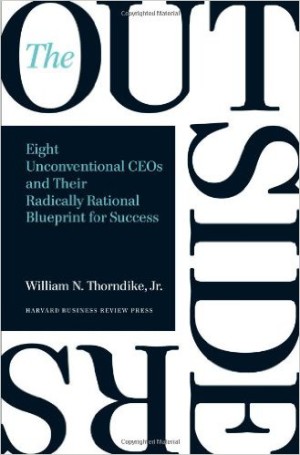This is the fourth and final post looking at how we can take the resource allocation checklist of The Outsiders by William Thorndike and translate it to the nonprofit world. The first three posts can be seen by clicking on the links at the bottom of the page.
 8. Retain cash in the business only if you can generate returns above your goals.
8. Retain cash in the business only if you can generate returns above your goals.
A couple decades ago a large relief and development nonprofit invited leaders from smaller organizations to visit for a half day consultation. I was lucky enough to be invited. At one point the CEO said, “We’re fortunate enough to have $75 million in a rainy day fund.”
Another invitee asked, “Since your work is in helping the poor, wouldn’t you say that it’s a rainy day for a couple billion people in the world? Why not take that cash and put it to work?”
It was an awkward moment, but the guy had a point. If you’re lucky enough to be in a position where cash — or time, or talents, or some other type of treasure — is accumulating, and you aren’t deploying all those resources, why not?
Start thinking about what your organization has bottled up. And start allocating it to make a difference.
9. If you don’t have any good investment options, consider paying a dividend to your stock holders.
I know, I know, nonprofits do not pay dividends.
But corporations paying dividends are basically sharing their profits with the people who helped them create those profits. You need to do the same thing in your nonprofit organization.
Start by paying your staff well. Then honor your donors — not with elaborate gifts, but with recognition and thankfulness. Praise your volunteers and find a way to serve them.
If your nonprofit produces non-tangible “profits” like a kid in school or a person who is transformed spiritually, then introduce those people to the folks who made it happen behind the scenes. That’s the kind of dividends your partners really want!
10. When prices are high, it’s okay to consider selling your business. It’s also okay to close under performing units.
Selling your business when prices are high is saying, “With that much money I can get a better return on investment somewhere else than I can with my existing business, so I will sell.” It’s not as hard to translate into nonprofit language as you might think.
For one thing, you might actually sell the underlying assets of your nonprofit. I know of churches who sold their properties and moved to other locations. They upgraded facilities, paid off debt, and expanded their impact. Don’t be forever hitched to the same location just because of tradition.
Or you might find that your initial goals are completed. It’s time to move on to a new community, a new school district, or even a new country. Strictly speaking that’s not “selling” your “business”, but it is pivoting as the return on investment in one location drifts lower because of your good work.
I’ve also seen situations where larger nonprofits took over smaller nonprofits that had an innovative approach to a problem. The founder of the smaller organization was able to redirect her time, treasure and talent toward a new challenge.
The point is that you might not “sell” your nonprofit, but you will encounter times when it’s time to make a major change. Do not be bound by tradition, do not be afraid to declare victory, and do not be adverse to well structured partnerships.
Regarding closing down under performing units, that’s a huge weakness in the nonprofit world. I’ve written about this before so you can jump to that post for more.
Hope these series of posts have helped you translate “corporate-speak” into nonprofit management!

